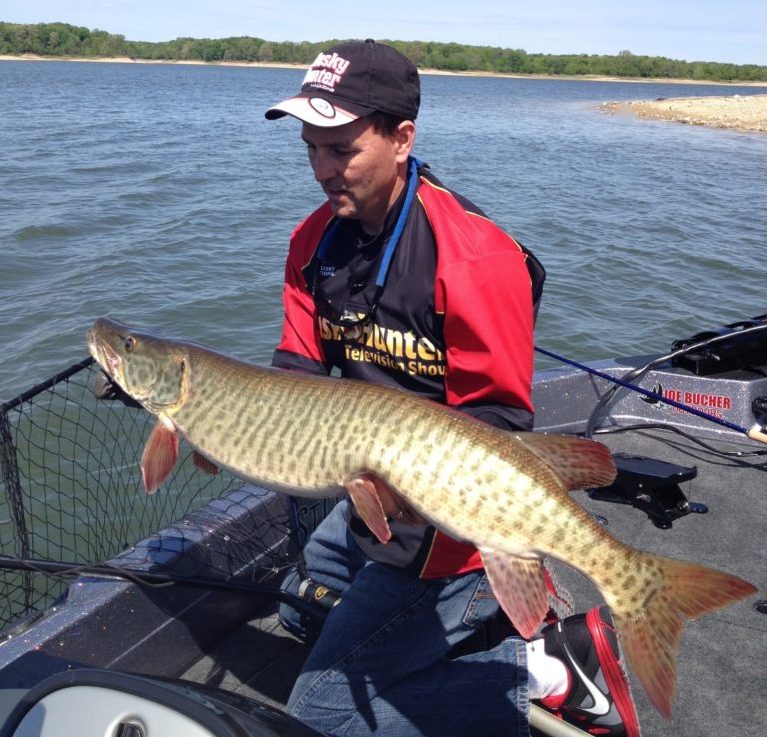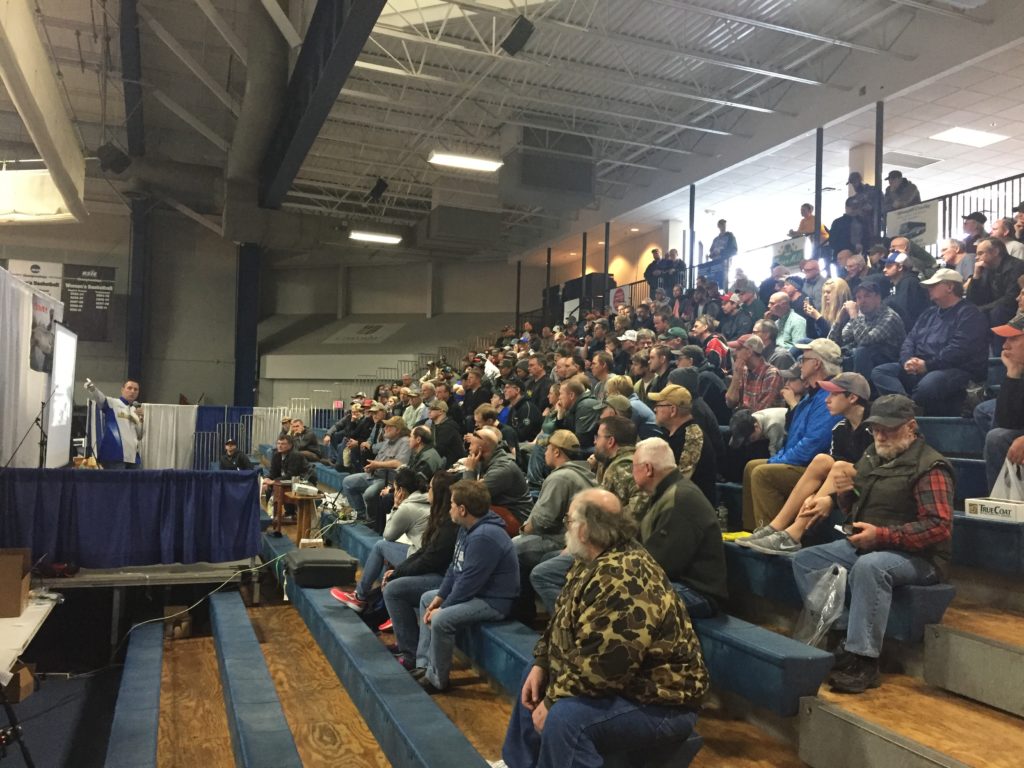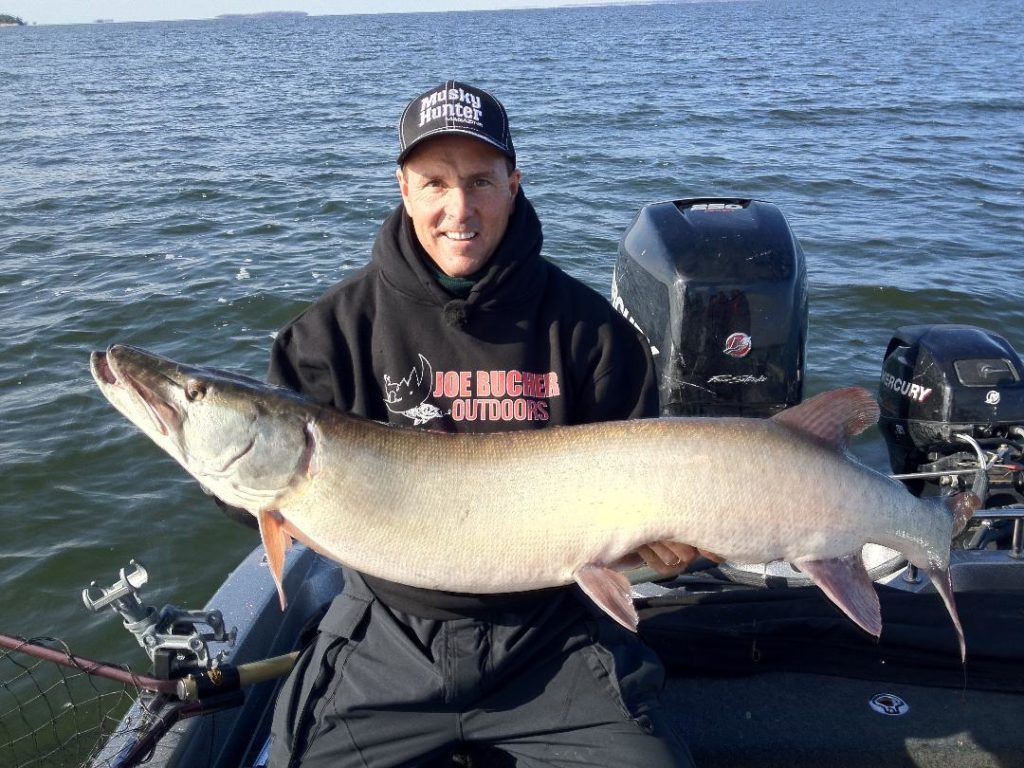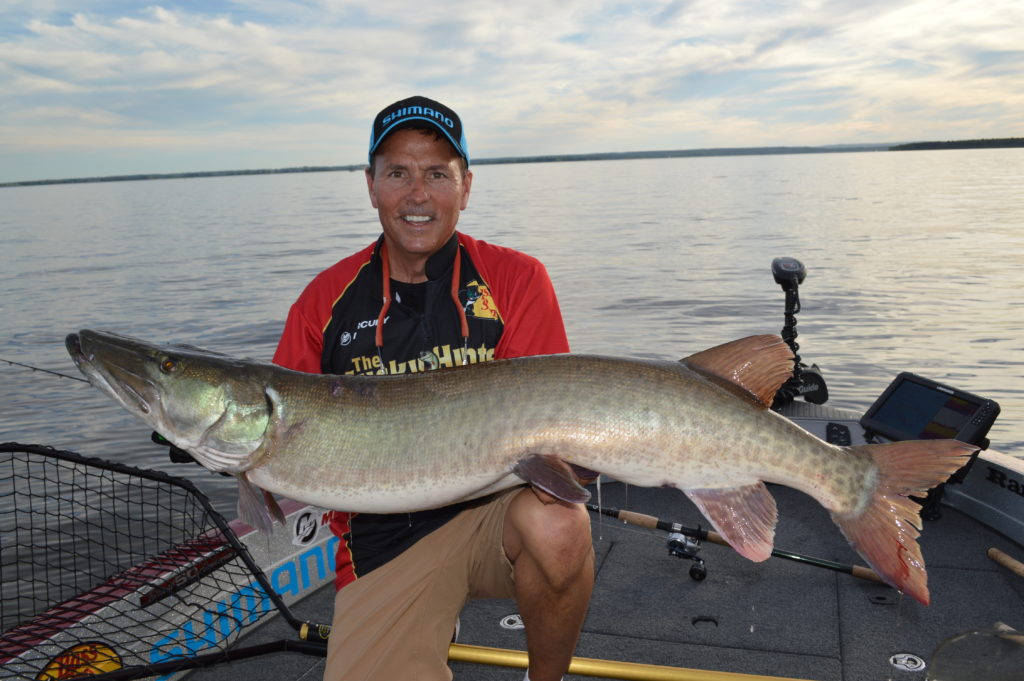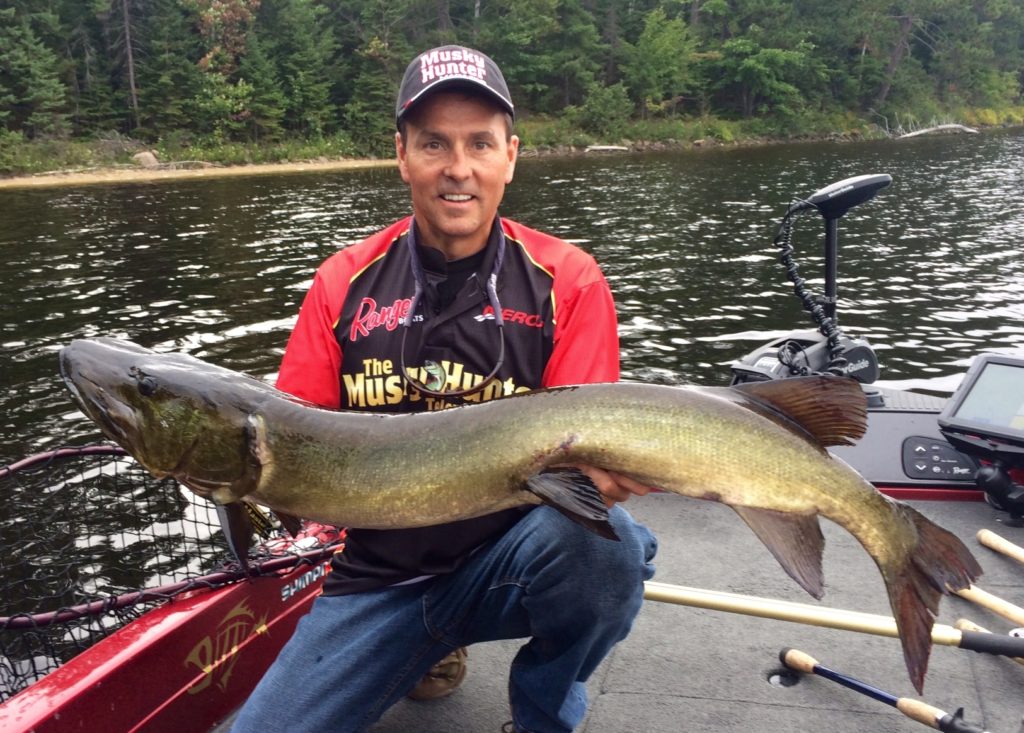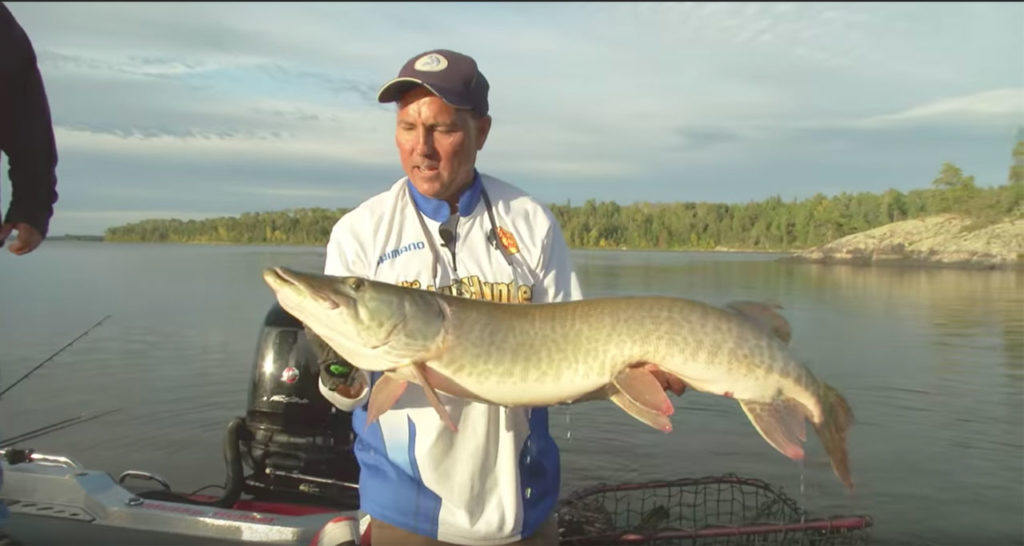Articles
FOUR SUREFIRE SPRING MUSKY SOLUTIONS
Want a shot at some early season muskies? Go south! There are lots of great waters in Illinois, Iowa, Missouri, Ohio, Indiana,Kentucky, Tennessee and Virginia. The great thing about these waters, besides having open water and supporting lots of muskies, is that the fish are generally active in early spring. The fact that these fish tend to feed primarily on sh
ad makes them more active, and fishing many traditional musky lures will produce action! However, it is not the lure choice that is difficult for most northern musky anglers that venture to these southern waters — it’s where to find the fish! Many of these reservoirs are huge and the individual coves or creek arms are larger than many northern waters. Also, consider the fact that many of the reservoirs don’t have any weed growth, and those that do have very little at this time of year. So where do you begin? Here are four areas to check out, at least one of which is sure to hold muskies in any reservoir.
When looking at a map of the reservoir, one of the first areas to investigate is the headwaters of the reservoir where the river(s) enter the system. It is not uncommon for there to be a resident musky population in these rivers and creeks, but there’s often the added bonus of a migration of some muskies upriver. Combine this with the headwaters often having the warmest water, and you have a recipe for success! Fishing the headwaters is often quite visual as you are casting to timber or even shoreline cover. Subtle points and small pockets is all it takes to hold muskies at this time. Just be aware that local storm events can turn some creeks and smaller rivers into mud overnight, which can significantly ruin your fishing. I do find that when the fish are in these creek arms that casting smaller musky lures seems to be most productive.
Another key area I have found muskies in early season in many reservoirs is along the rip-rap near the dam. For some reason the muskies still use the rip-rap even though this is the opposite end of the reservoir and often the water is the coldest in these areas. It must be a predator/prey thing as there usually are bass and walleye also using the rip-rap. The muskies aren’t feeding on the bass or walleye , they are feeding on the shad and/or crayfish in these areas. It is not uncommon to be catching muskies along the same rip-rap section while someone else is catching bass. Believe me, if the muskies were actively feeding on the bass, the bass anglers wouldn’t be catching them at the same time. Trolling 5-inch depthRaiders and shad-imitating crankbaits is a great way to cover large rip-rap areas. However, casting crankbaits and glider jerkbaits is also effective.
While near the dam area another interesting phenomenon I have seen in many different reservoirs is that often the first major creek arm adjacent to the dam will hold a good population of muskies at any time. The muskies that live near the main lake in summer do not all migrate upriver to the headwaters to spawn. Instead, they will move into the first major creek arm. These creek arms can be huge areas to fish, but focus on the larger concentration of shad in these creek arms, as well as the warmest water within this first major creek arm. Once again, glider jerkbaits, minnowbaits such as Shallow Invaders and ShallowRaiders, and smaller Bulldawgs are most in early season.
Last, but certainly not least on the list of early season areas to explore are the marinas. Unfortunately in some States fishing around the marina is not legal. However, in most places you can join the bass and crappie anglers and fish in these areas. As I have said before, I have never fished a reservoir that didn’t have muskies near a marina. These marina areas offer lots of shade and other man-made cover for the shad and are usually located adjacent to deep water areas of a cove. In fact, the marina may serve as a conduit from the deep water to the shallow water in the back of the cove. So it certainly makes sense why these areas can be so good and hold muskies. If you launch your boat in the back of a cove, often times adjacent to a marina, make a habit of fishing your way out and around the marina to the main lake and you often won’t be disappointed.
I don’t know about you, but after a long winter and talking muskies with everyone at sportshows, I can’t wait to hit the water. The warm days of March, April and May are a prime time to get a jump on your season. Don’t let the size of a reservoir intimidate you this season. You know how to catch them, just keep the location principles simple and go hunt them down.
MAXIMIZE THE MUSKY SPORTSHOW SEASON
With the real musky season wrapped up across the musky range, it’s time for the “sportshow season” of musky fishing. This is the time of year we watch fishing television shows, attend sportshows and do whatever it takes to make it until we can make our next cast. Consider this an opportunity to maximize your upcoming musky season. As musky anglers we are very fortunate as there are seven musky-specific sportshows. That means there are ample opportunities to commiserate with other musky anglers, who wish they could be fishing right now. Plus, it’s a great opportunity to check out the latest musky tackle, plan your next musky trip, and take in a seminar to learn a new technique. However, before you head to a sportshow, here’s a few things to do to maximize your experience, as well as a few ideas to prepare for the season.
First, take a closer look at all of the musky rods and tackle boxes that were left in your basement or garage at the end of the season. Take a little time and make note of a few items that need repair and/or replacement. Believe me, it will help you purchase what you really need this winter. Of course if you see a hot colored lure, you better buy that too! Don’t make the mistake of waiting until spring to look over your equipment and then realize last minute you are in need of repairs or replacements. While looking at your musky rods, do you have any damage to your rods? Also, consider which rod additions you’ll need for next year. Now’s the time to decide. You are better off going to a sportshow with a specific rod-action in mind to cast certain lures, rather than randomly checking out rods. This will help you make the most of your winter-time rod purchase.
Reels are an entirely different animal. Most likely there will be some reels that need repair or at a minimum a good cleaning. Be sure and loosen the drags on all the reels and put the ones that need repair in a bag. This way you can take the bag to someone who repairs reels and have them all fixed now rather than waiting until March or April. Also, at some shows Shimano has a repair table and they will teach you how to clean your reels under expert guidance. This is definitely a learning experience.
Being a musky hunter, your tackle is worth a lot. We all have a large number of expensive musky lures and always need more. Take a quick inventory of which ones you will need duplicates or replacements. Plus, this will give you an excuse to go to one of the musky sportshows and purchase replacements, besides the many new lures you’ll buy because they look great or are simply the “next big thing”. In the end, you’ll come home with lures that you’ll really need. One approach is look at each group of lures, (i.e. crankbaits, topwater, etc.) and decide which color patterns are missing. You might have a bunch of perch pattern crankbaits, but few with cisco or sucker patterns. So, make a note to get a few of those. Finally, while on the subject of lures, if you are planning on fishing a new water next year, make a list of specific lures and colors you might need. Sportshows can be overwhelming, and the list just ensures you don’t forget something. Of course, there’s nothing wrong with spending another day at a musky show!
Here’s my simple strategy when attending sportshows. The busiest times are when the show first opens and Saturday afternoon, unless you need a specific lure, try and avoid those times. If you have a specific lure or custom color pattern in mind, I would recommend being there when the show first opens and heading straight to that vendor and purchasing that first. It’s amazing how quickly the next “hot” lure can sell out, or new color patterns quickly disappear. From there take the time to check out all the new gear, chat with guides and resorts. If you are looking for a new place to chase muskies, all of the experts will be there and willing to provide helpful information. Be sure and attend a few seminars. We can all learn something new that may help us wherever we fish. Finally, relax and enjoy the experience, afterall, it’s a long winter.
If you can’t attend a sportshow, you can still purchase all of the equipment you need at a local retailer such as a Bass Pro Shops or Cabelas or online specialty shop. Also, here’s a few other important things to consider to prepare you for the season.
I keep logs of all of my musky catches and I highly encourage you to do the same. Before you start your new season, go back and complete your logs for your final fishing days. Just as important write down some notes on various lakes, patterns, etc. It’s amazing how simple, random notes can help you remember things when you fish a particular lake the following year. My fishing logs have data on all of my catches, but I also have a comment field that is helpful to use as a summary or a memory-jogger for future trips. This information takes minutes to update, but is simple invaluable.
Obviously, take good care of your boat, motor and trailer, as it’s your largest investment and it’s important that it’s running properly the following season. Boat, motor and trailer problems always frustrating and can ruin a trip.
Finally, make this winter a time to take care of yourself as well. Exercise and getting in shape will really help you when musky fishing next season, as you’ll be able to fish longer. Also, you’ll be less impacted by the weather elements and be able to better focus on the water. Plus, the benefits of exercise will help you in other aspects of your daily life as well. Musky fishing doesn’t have to end if you aren’t able to fish until spring. Make the most of the off-the-water season. Between taking a lure inventory and fixing equipment, attending sport shows, watching musky television shows, and reading books and magazines, and spending time on social media, you have a lot to keep you busy.
THE FALL MIGRATION
It was a blustery and cold northwest wind. Every time we turned the boat into the wind the spray from a wave crashing into the side of the boat got someone wet, and ice crystals were beginning to form on the boat floor. It was a perfect late fall musky day! We had been trolling for hours with no results, but with conditions near perfect, and bait stacked up along the breakline we knew it was just a matter of time. After another hour the silence was interrupted with the screaming of the drag from the reel. Turning around it seemed like forever before we all realized which rod was pounding from the thunderous musky strike. Fortunately, it was my turn and I grabbed the rod. After sitting and driving the boat in the cold for several hours, my muscles were slow to respond to the change in motion and the battle was magnified. Initially, you always feel handicapped until your body catches up and adrenaline takes over. The fish stayed deep and the big waves amplified every headshake and kept my Shimano Sojourn rod doubled over. After a few minutes as the beast approached, my boat partner netted the giant. We took a few photographs and within a couple minutes the 52-inch beast was swimming away to fight again another day. Hi-fives were plentiful in the boat after that and another great fall memory was created.
That is fall musky fishing at its finest. As the water temperatures drop and freeze approaches, muskies make a fall migration towards their spawning areas and stage adjacent to them. Once located these areas can be musky magnets and each day can bring more muskies to the area. It seems as the water temperatures drop more fish tend to load into the spot. In theory, it should be pretty easy to locate and catch these concentrated groups of muskies, but that’s not always the case.
First, you need to locate the potential spawning areas. You can look are large shallow bays, adjacent to deep water, or large incoming creeks or rivers with flats in front of them as potential musky staging and spawning areas. This is when checking with your local department of natural resources can help. They are usually willing to point you in the direction of areas where muskies spawn. One thing to remember is that they don’t know all the spawning areas, so don’t ignore areas that appear to have spawning area and hold muskies.
Once you have located the spawning area, there’s really only two techniques I rely upon at this time, either troll the adjacent breakline or drop off, or cast giant pounder Bulldawgs. Pick your poison, but either can be effective. When fishing the breakline focus on the various subtle points and turns. Pay close attention to projections toward deep water or the inverse, which is an area where the deeper water swings tighter to the spawning area. Both of these scenarios are potential spots that may hold and concentrate muskies.
The next step is trying to get the muskies to bite and establish the depth of the day. With the water temperatures in the mid forties and colder the muskies aren’t doing a lot of moving, because they are finally near their wintering area adjacent to the spawning grounds. If there is significant bait in the area, they may stay in this area for a prolonged period. Their movement becomes more vertical in the water column to feed, during short feeding windows, rather than wandering everywhere to feed. Therefore, getting the muskies to bite can be difficult. This is why trolling is so effective at this time, as you simply always have a lure in the water. Keep trolling multiple depths and make multiple trolling passes in these staging areas. Once you catch a musky you have not only found the key depth, but may have located a precise spot where you can catch multiple muskies. The same approach holds true when casting large soft plastics. Try and determine if the muskies are located along the top, side or bottom of the breakline. Once established you can adjust your boat position to most effectively fish that depth. I have several lakes I fish in fall that have steep breaklines adjacent to a large flat that’s the size of a football field, and the majority of the muskies are caught from the same specific spots, every year. Your GPS waypoints are gold in late fall.
My top trolling lures at this time are straight model Depthraiders and 9 inch ShallowRaiders. Trolling speeds are slower in the 1.8 to 3 mph. As a general rule in stained water target depths of 12-18 feet and in clear water focus on depths of 15-28 feet.
In late fall you really can’t cover a lot of water with shorter days and short feeding windows. Fortunately, you don’t have to search far if you know where the spawning areas are located. Keep your baits in the water, keep experimenting and you’ll strike late fall gold.
TRIGGER STRIKES NOT FOLLOWS
We were in the middle of the classic mid-afternoon summer lull, something every musky hunter has experienced. The wind was gone and so were the clouds. The sun was beaming and despite having applied sunscreen for the second time, I could feel it burning my skin. The temperature and humidity were both extremely high and the muskies seemed to be non-existent for the last couple hours. We returned to a couple locations we had seen muskies earlier in the morning to use them as a barometer to determine if we had been fishing spots that weren’t holding muskies, or if indeed they just weren’t moving. On our third spot where we had either seen or caught a musky earlier, I switched to a smaller bladed bucktail and decided to just start reeling as fast as possible. I vividly remember making an exta-long cast, lowering my rod tip towards the water and cranking fast. I jokingly yelled to Tom, it was time to “shock the world”. Seconds later the rod was almost ripped out of my hand, as I experienced a ferocious strike from a musky. Tom and I just couldn’t stop laughing in the moment from what just transpired, and that made landing the 45 incher a little more difficult than normal. Ultimately, we landed and released the musky.
We gathered our composure and decided to test our new theory that super-speed was needed to trigger strikes in the heat. Over the next couple hours we boated two more muskies and had follows from a handful of other muskies. When we went in for dinner we couldn’t believe how that speed change seemed to turn everything around and how the muskies came alive. To this day, we often turn to shock the world, and are still amazed how it can spark a strike. Simply, use a high-speed reel such as a Shimano Tranx 400 spooled fully with 80-100 pound test PowerPro, point your rod tip at the lure and crank fast!
The above example was not a one-time experience as speed has produced on numerous occasions. There’s no question the one theme to keep in mind when fishing muskies during summer is that you need to rely on speed to trigger strikes. Slower speeds tend to produce more follows, but speed makes them bite. Speed applies to not only in-line spinners, but jerkbaits and minnowbaits as well.
When your fishing partner is burning a bucktail you need to be able to fish a lure that can compliment that speed. Afterall, if you are fishing fast in the front, the boat tends to move faster as well. So, it’s difficult to follow-up with a slow moving presentation. A perfect second bait choice is a side-to-side glider-style jerkbait. Rather than fish the lure slowly, try using several fast jerks and cranking quickly between them to really get the lure moving fast and erratic. It’s often exactly what it takes to trigger a speed-strike in summer. Just make sure to once or twice during each cast pause the lure for an extra second or two. That way when a musky engages your lure and is in hot pursuit, that two-second pause, followed by the lure exploding away from the musky often triggers a strike.
Another summer lure I use a lot is a 9” ShallowRaider. I love fishing big minnowbaits in summer as their size and profile make it easy to create a lot of commotion. During summer I try and make a lot of cover collisions with this bait and use a lot of speed as well. My go-to retrieve at this time is a hard rip/pause retrieve. I typically move the rod about 18 inches with each rip and quickly pick up the slack. I am keeping the bait moving forward, and accelerating it with each rod rip. If it bounces off a rock, that just seems to make the overall retrieve even better. With these large profile lures, it’s easy to get the attention of a musky. The fast and erratic retrieve gets them to bite. I don’t want a musky to follow, I prefer they either hit it or get out of the way. If a musky was spotted earlier in the day on a spinner, this is a great lure to use the second-time through the spot.
Summer days are long and there’s lots of spots to fish, if you are getting lots of follows, or if the muskies seemed to disappear, try cranking up the speed and get the muskies attention. You might convert those followers to strikers!
3 KEYS TO YOUR PERSONAL BEST MUSKIE IN 2018
What was your largest muskie in 2017? Did you meet your muskie fishing goals? As muskie anglers we all are on a quest to catch the biggest muskie. It’s not about numbers, unless of course it’s a bunch of big ones. That’s what makes muskie fishing different from fishing for other species. If you want to catch bigger muskies in 2018 and are on a quest for your personal best, there are many things that you can focus on during the frozen water period that can pay big dividends come summer. There are multiple things that can help but three areas to focus are research, inventory, and education. The amount of effort you put in directly impacts your results.
Do you have a lake X? By lake X I mean a lake, river or reservoir you are fishing that few others are muskie fishing. Maybe you haven’t fished this lake X but you have heard about it, but plan to fish it in 2018. If you have such a new water on your radar screen now is the time to research the lake. Start by investigating the local Natural Resources departments records, making some phone calls or sending emails. It’s important to know such information as stocking records to predict strong year classes of muskies or anticipate when a population may be realistically fishable. Also, remember that much of a muskies lifetime revolves around spawning areas, so it’s imperative to know where the muskies spawn. This will help with both spring and fall muskie locations. Another research question to answer is when are the big muskies most susceptible? Typically there is a week or two every year when more big muskies tend to get caught on any water. That’s when you need to be there. Look at online photos from resorts or guides and note the date when the fish were caught. Checking multiple sources allows you to put together this puzzle. Believe me, determining this window of opportunity can be the single most important factor in putting success in your favor. If you are attending muskie sportshows be sure and check the dates any photos you may see. While looking at photos, be sure to make a mental note of sky conditions. Do most of the muskies come from sunny or cloudy conditions? Also, you might even see a lure or two lying on the front deck, and that might provide some further clues. One last thing to consider when researching a lake is to take advantage of social media. YouTube and Facebook can be valuable tools to view photos and videos from the water you are researching. This research can be fascinating and take hours. It’s a great way to really learn everything from where you should stay, launch your boat, and ultimately where to fish and what lures to use. You can gain a tremendous advantage and can almost feel you have been to the water before you even get there!
Once you have done your research and have a better understand the type of fishing you will be doing on your trip to lake X, it’s time to take an inventory of your equipment. I could be you need more of a particular lure and/or color. For example, based upon your research, rather than fishing Cowgirls, maybe you’ll need more smaller Showgirls and fish them faster. So, you might need more Showgirls in multiple colors. Likewise, review your rod and reel selection. Again, you might need a medium-Heavy action Shimano Compre rod rather than an extra heavy model to obtain maximum casting distance and feel the vibration of the smaller blades. If you are going to need to fish fast, you’ll need to revisit your reel inventory and maybe get a high-speed Shimano reel to make life easier. My point is that once you do your research, you should take the time to check out your equipment and make sure you have everything you need for the upcoming season. The last thing you want to do is go to your new lake, and not have what you need. Even if you aren’t sure what lure(s) you will need, your research will give you a general idea and you can have a better sense of what you might need while shopping at sportshows this winter.
The final piece of your wintertime muskie agenda is education. We all have our strengths and there’s no need to work on those, but it’s those weaker areas that we may have previously avoided that we should try and tackle. For example if you don’t have a lot of confidence casting soft plastics this winter is the time to attend seminars and talk with muskie experts that spend hours fishing these lures. A simple conversation with a guide can really help you better understand or answer your questions that can give you more confidence in using these lures. Even if you don’t think you’ll be fishing a particular lure on Lake X, it’s always good to broaden your horizons as you never know when a new technique will help. If you can catch a couple muskies next year on a new technique you might gain enough confidence to use it more and better understand how to work it into your repertoire of techniques.
Every new muskie season is exciting as we dream of what will be. Take the time to research, inventory and educate yourself this winter and you’ll take your catches to another level. My motto has always been fish hard and fish smart, and these wintertime activities build the foundation of fishing smart.
TOOLS TO TACKLE MUSKIES THIS WINTER
Being heavily involved in the muskie industry it’s pretty common to get approached and see many new products and ideas before they hit the market. It’s amazing to see some of these ideas develop from concept to implementation and become the next big thing in muskie fishing. This winter while awaiting open water or your first spring trip, by watching television shows, reading magazines, trolling social media, or attending sports shows, consider picking up a few of the following items that can really assist you this season.
We all have our favorite muskie reels. I get asked all of the time about various new reels on the market. Certainly, I am a big fan of Shimano and I had a chance to test the new Shimano Tranx 300 and 400. There is no question the Tranx 400 is the ultimate muskie reel. It’s comfortable and extremely durable and I use if for almost all of my musky fishing applications. However, get into a discussion about muskie reels with a group of musky hunters, and the conversation quickly turns to actual reel handles. Some anglers prefer the larger power handles with one large knob and others prefer the standard paddle handle with two knobs. The handle style actually impacts the mechanics of how you reel. For example, using a traditional handle involves primarily the wrist, whereas the power handle, gets the shoulder muscles involved. If you have any wrist or shoulder issues, changing reel handles can relieve the pain. Generally, if you need to retrieve baits at high speed, or if you are using hard pulling lures such as a Cowgirl the power handle is a must. I use the Shimano Tranx 400a for fishing Cowgirls, but I place the Power handle on the reel for more leverage. If you are using other lures such as a topwater or minnowbait, the traditional handle makes fishing these lures much easier, and you can fish them slower and with more finesse. Also, there are different size traditional and power handles available that are made by various manufacturers. Depending upon your hand size, a smaller or larger handle may increase comfort. Consider purchasing a different handle to upgrade or convert a reel that best suits its intended purpose.
Going through your tackle during the winter can be a difficult task. Although, it’s necessary because we have to figure out what else we need. If you have a bunch of bucktails that are beat up from being eaten by muskies, besides buying extra replacements, consider rebuilding them yourself. There is a new bucktail tying tool made by DuBro products. I recently watched a video of how it works and this tool makes rebuilding bucktails simple. Bucktail components are available in many tackle shops. You can keep this in your garage or workshop and rebuild your favorite bucktails. It’s a great way to spend a winter day!
While on the subject of workshop activities. Why not take the time to replace the hooks on your favorite lures and sharpen them as well. A pair of good quality split ring pliers and a flat-sided hook file are two must-have purchases every winter. With the heavy duty split rings we use when muskie fishing and the large hooks, I go through a pair of split rings and a couple hook files every year. Now’s the time to tweak or upgrade a few of your favorite lures and split ring pliers and a new file is a great combination to make life easier. Don’t struggle with a worn out hook file. It’s a relatively inexpensive investment that can significantly increase your odds in landing the next muskie that strikes.
Another gadget I recently saw was the Heavy Head by Musky Innovations. If you fish soft plastics such as Bulldawgs and wished they could run deeper, the Heavy head makes it possible. This is a uniquely shaped weight with metal loops on each end that attaches to the bottom nose of a Bulldawg. One loop goes over the nose of the bait where you would attach your leader and the other end goes over the hook-hanger of the front hook. This way the weight is securely fastened to the lure and will not impact hooking ability. Plus the lure is in the front to enhance the lure’s action. Whether you fish softplastics fast or slow. There always seems to be a situation to want them to run deeper and this is an easy way to accomplish it.
While walking the isles of the muskie sportshows, or browsing through catalogs or websites, consider picking up a few of the above-mentioned items. They will get your gear in top shape so you’ll be ready when it’s time to hit the water.

